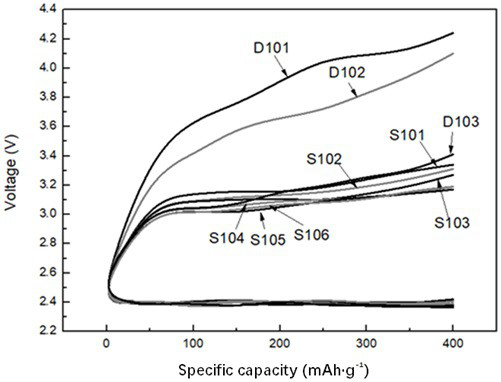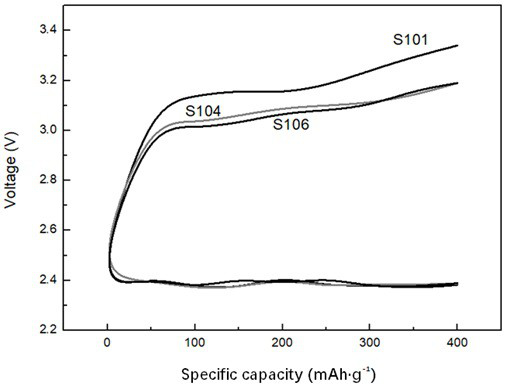Lithium battery electrolyte, application of lithium battery electrolyte and lithium oxygen battery containing electrolyte
A lithium-oxygen battery and electrolyte technology, applied in the field of electrochemical materials, can solve the problems of limited use effect of solid catalysts, difficult to achieve commercialization, and high charge and discharge potential, and achieve improved electrochemical performance, reduction of overpotential during charging, and rate of charge. The effect of performance optimization
- Summary
- Abstract
- Description
- Claims
- Application Information
AI Technical Summary
Problems solved by technology
Method used
Image
Examples
Embodiment 1
[0059] A lithium oxygen battery:
[0060] Positive electrode: acetylene black positive electrode;
[0061] Negative electrode: metal lithium negative electrode;
[0062] The composition of the electrolyte is: the solvent is tetraethylene glycol dimethyl ether, the lithium salt is 1 mol / L lithium bistrifluoromethanesulfonylimide, the additive is thioacetamide, and the concentration of thioacetamide is shown in the table below.
[0063] Contrast table of thioacetamide concentration used in each test group of embodiment 1.
[0064]
specific Embodiment 2
[0076] The additives used in each test group of specific embodiment 2 are shown in the following table.
[0077]
[0078] The lithium-oxygen batteries of each of the above test groups were tested the same as in Example 1, and compared with the S105 test group. Specific as Figure 4 shown.
[0079] from Figure 4 It can be clearly seen that the use of other similar additive components, although compared with the D101 blank control group, has a certain improvement effect, but compared with the thioacetamide used in the present invention, they are far inferior. For example, the D204 test group is the closest to this application in terms of charging curve trend, but it only has the first 100-150 mAh·g -1 platform, but there is no second 200-300 mAh·g -1 platform, so the subsequent potential rise is too large. The rest of the test groups also have similar situations, most of which have 100-200 mAh·g -1 platform, but there is no second 200-300 mAh·g -1 platform. It shows ...
Embodiment 2
[0084] A lithium-oxygen battery, the negative electrode and electrolyte of which are the same as those of the S105 test group in Example 1, the difference being that the positive electrode uses a graphite electrode, and the battery test group obtained is marked as S200.
[0085] The same test as S104 was carried out on S200, and compared with the S104 test group.
[0086] The comparison results are as Figure 11 shown.
[0087] from Figure 11 It can be clearly seen that after replacing the acetylene black electrode with graphite, although it still maintains a good anti-polarization ability, the 200-300 mAh·g -1 The trend of the platform weakens or even basically disappears, indicating that acetylene black has a certain promotion effect on the generation of the platform of the second charging curve, or there is a synergistic effect. The researchers believe that the generation of the second platform requires the positive electrode material to be more effectively infiltrated ...
PUM
 Login to View More
Login to View More Abstract
Description
Claims
Application Information
 Login to View More
Login to View More - R&D
- Intellectual Property
- Life Sciences
- Materials
- Tech Scout
- Unparalleled Data Quality
- Higher Quality Content
- 60% Fewer Hallucinations
Browse by: Latest US Patents, China's latest patents, Technical Efficacy Thesaurus, Application Domain, Technology Topic, Popular Technical Reports.
© 2025 PatSnap. All rights reserved.Legal|Privacy policy|Modern Slavery Act Transparency Statement|Sitemap|About US| Contact US: help@patsnap.com



